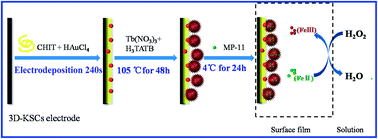In this work, a novel hydrogen peroxide (H2O2) electrochemical biosensor was developed based on the metal–organic framework (MOF, Tb@mesoMOF) modified three-dimensional (3D) kenaf stem-derived macroporous carbon (3D-KSCs) electrode which was used as a new platform to load microperoxidase-11 (MP-11) for the first time. The chitosan-Au nanoparticles (CHIT-AuNPs) were firstly electrodeposited on the 3D-KSCs integrated electrode, which provided a large number of active sites for the growth of Tb@mesoMOFs to form the Tb@mesoMOFs/CHIT-AuNPs/3D-KSCs integrated electrode. Then the MP-11 molecules were effectively encapsulated in Tb@mesoMOFs of the Tb@mesoMOFs/CHIT-AuNPs/3D-KSCs integrated electrode. Scanning electron microscopy and energy disperse X-ray spectroscopy was used to characterize the resulting electrode. The results showed that a large number of spherical Tb@mesoMOFs grew on the CHIT-AuNPs/3D-KSCs electrode uniformly and firmly. The electrochemical performance of the MP-11/Tb@mesoMOFs/CHIT-AuNPs/3D-KSCs electrode were also explored. The resulting MP-11/Tb@mesoMOFs/CHIT-AuNPs/3D-KSCs integrated electrode showed good performance toward the detection of H2O2 with a wide linear range from 3.02 μM to 640 μM and a low detection limit of 0.996 μM. This work provides new ideas to design MOFs/3D-KSCs integrated electrodes for enzyme immobilization to construct electrochemical biosensors.

